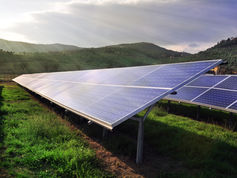The Uses of Flow Batteries
- Otto Gunderson

- Mar 12
- 2 min read
For someone unfamiliar with the topic of flow batteries, Eugene Beh, the Founder and CEO of Quino Energy, put it in easy-to-understand terms. The simplest way to understand flow batteries is to think of them like a conventional car: a fuel tank and an air intake are used in the engine to produce movement. Similarly, flow batteries require fuel, oxidizer, water, and solvent to extract chemical energy. Flow batteries store the liquid electrolytes (think fuel) separately, and they then flow into the central cell. This flow into the central cell will then result in the charging, or discharging, of the battery.

The use cases for flow batteries are centered on energy storage. With solar projects continuing to have intermittency problems, having a way to store additional energy so as to avoid negative pricing is crucial. Negative pricing for excess renewable energy continues to strain the industry, and the low cost of flow batteries could be a significant possibility.
Flow batteries have the ability to store hundreds of megawatt hours of energy, with the capability to power thousands of homes for hours with a single charge. MIT Associate Professor Fikile Brushett described the difference between flow batteries and those in EVs and phones. As he puts it, “A flow battery takes those solid-state charge-storage materials, dissolves them in electrolyte solutions, and then pumps the solutions through the electrodes." This makes them excellent candidates for long-duration storage.

As Beh explained, one outlet for innovation and improvement in the development of the flow battery industry is improving installation. The cost of installation can be reduced by using the carbon steel tanks already available at many shipping ports and refineries. This could also allow the oil industry to enter the flow battery market, as the storage tanks traditionally used for petroleum could be repurposed.
The uses of flow batteries are varied. They are most commonly considered a grid storage solution, preventing negative pricing during peak renewable energy production while providing on-site storage. If safety is a concern, such as in data centers or hospitals, flow batteries may be a better option than lithium-ion due to their non-flammability. Similarly, flow batteries are a compact option in cases where space is an issue, such as in a densely packed urban area. Stacking the batteries vertically can mean more storage for smaller areas than lithium-ion.
Additional benefits to a flow battery solution include the materials that are found in their production. Flow batteries rely heavily on commonly available materials, and the cost of materials is lessened due to the recyclability of the battery. The need for multiple energy storage solutions is not a zero-sum game. Flow batteries, lithium-ion, sodium-ion, and other storage methods all play a role in this transition. This is backed by European Union Research, which anticipates 20% growth annually until reaching at least 45 GWh by 2030. Simultaneously researching and commercializing various storage options is crucial to meeting decarbonization targets.













Comments